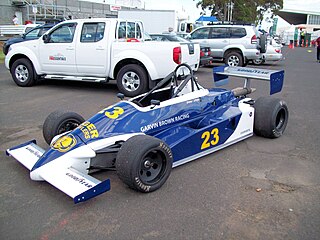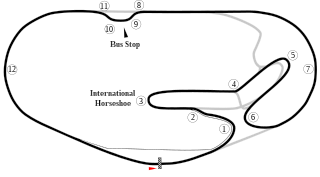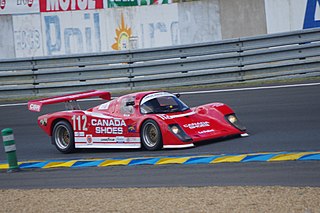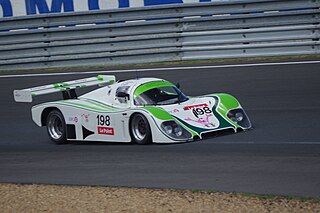Related Research Articles

Spice Engineering was a British racing team founded by driver Gordon Spice with Raymond Bellm in the early 1980s, later becoming a successful sports car constructor in 1986. They competed in the World Sportscar Championship in Europe as well as the IMSA GT Championship in North America, at times partnering with major manufacturers such as General Motors and Honda as well as race engine manufacturer Comptech.

IMSA GT was a sports car racing series organized by International Motor Sports Association. Races took place primarily in the United States and occasionally in Canada.

The 1984 Sandown 1000 was an endurance motor race staged at the Sandown Raceway in Victoria, Australia on 2 December 1984. It was the eleventh and final round of the 1984 FIA World Endurance Championship and was the first FIA World Championship race to be held in Australia. It was to be the first of a three-year contract to race at Sandown, though the final two years would be cancelled.

Tiga Race Cars Ltd. was a British auto racing constructor and team. The company was founded in 1974 by two former Formula 1 drivers, Australian Tim Schenken and New Zealander Howden Ganley. The company's name was formed by the first two letters of Tim and Ganley. Tiga constructed racing cars for various forms of open wheel racing and sports car racing, ranging from Formula Ford to the World Sportscar Championship.
Embassy Racing was a British auto racing team founded by Jonathan France in 2003. Initially created as a conjunction with Xero Competition in the British GT Championship, the team expanded to become an independent team and began to win races in British GT before the team took a sabbatical year in 2006. Upon their return to motorsport, Embassy moved to the international Le Mans Series, running in a Le Mans Prototype class, as well as entering the British Superbike Championship's junior leagues, the Supersport and Superstock Championships, running with the support of Triumph Motorcycles under the MAP Embassy Triumph banner.

The 1986 ADAC Kouros 1000 km Nürburgring was the seventh round of the 1986 World Sports-Prototype Championship. It took place at the Nürburgring, West Germany on August 24, 1986.
Sean Walker is a British former racing driver. He stopped racing in 2013. His father Ian Walker (1926–2008) was noted as the "Doyen of British Motorsport" was a driver, engineer and designer/modifier of race cars particularly Lotus. Ian Walker's cars were driven by famous drivers such as Jim Clark, Graham Hill and Peter Arundell.
The Dallara GC21 was a Le Mans Prototype built by Dallara for the Fuji Grand Champion Series, and based on one of the company's Formula Three cars. It was raced between 2002 and 2007, competing in the LMP2 class of the Japan Le Mans Challenge in the last two years of its usage. A GC21, entered by MYZ, won the LMP2 category of the Japan Le Mans Challenge in 2006.
The Lamborghini Countach QVX, occasionally referred to as the Lamborghini QVX, was a short-lived Group C sports racing car built in 1985. It was not built or designed by the Lamborghini factory, but instead used a Spice Engineering-built chassis and an engine derived from the Lamborghini Countach's V12. Lamborghini's British importer commissioned the car. Financial issues restricted it to one race, despite numerous entries in 1986 and a handful in 1987, but its one race showed the car had potential.

The March 86G was a Group C and IMSA GTP sports racing car built by March Engineering. Built as simply a chassis with no engine, it was branded as one of three cars, the BMW GTP, the Buick Hawk or the Nissan R86V depending on which engine was placed in the chassis and which team was running it. There were a number of subtle bodywork changes to reflect the manufacturer which ran the car.

The 26th Annual SunBank 24 at Daytona was a 24-hour endurance sports car race held on January 30–31, 1988 at the Daytona International Speedway road course. The race served as the opening round of the 1988 IMSA GT Championship.
The March 82G is a IMSA GTP/Group C sports prototype race car, designed, developed and built by British manufacturer and constructor March Engineering, for sports car racing, in 1982. It competed in motor racing between 1982 and 1986, but only scored 1 race win, 8 podium finishes, and 2 pole positions. It was powered by a naturally-aspirated 620 hp (460 kW) 5.7 L (350 cu in) Chevrolet V8 engine.

The Tiga GC287 is a sports prototype race car, designed, developed, and built by British manufacturer Tiga Race Cars, for sports car racing, conforming to the Group C2 rules and regulations, in 1987.

The Tiga GC286 is a sports prototype race car, designed, developed, and built by British manufacturer Tiga Race Cars, for sports car racing, conforming to the Group C2 rules and regulations, in 1986.
The Tiga GC285, also known as the Tiga GC85, is a sports prototype race car, designed, developed, and built by British manufacturer Tiga Race Cars, for sports car racing, conforming to the Group C2 rules and regulations, in 1985.
The 'Tiga GC83 is a sports prototype race car, designed, developed, and built by British manufacturer Tiga Race Cars, for sports car racing, conforming to the Group C1/C2 rules and regulations, in 1983.

The Tiga GC288 is a sports prototype race car, designed, developed, and built by British manufacturer Tiga Race Cars, for sports car racing, conforming to the Group C2/IMSA GTP Lights rules and regulations, in 1988.

The Tiga GC289 is a sports prototype race car, designed, developed, and built by British manufacturer Tiga Race Cars, for sports car racing, conforming to the Group C2/IMSA GTP Lights rules and regulations, in 1989.
The Tiga GT286 is a sports prototype race car, designed, developed, and built by British manufacturer Tiga, for sports car racing, conforming to Group C2 and IMSA GTP Lights rules and regulations, in 1986, and continued competing until 1993.
The MCS Guppy is a Group C2 sports prototype racing car introduced by Mooncraft in 1983.